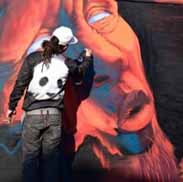GLY1102 Topic 27, GLY1102 Topic 28, GLY1102 Topic 29
Unlock all answers in this set
Unlock answersquestion
Although some fossilized dinosaur organs have been recovered, none of these is of a heart.
answer
False
question
Bacterial infection from bites and scratches may have been lethal to dinosaurs.
answer
True
question
Three-dimensional vision occurs because each eye sees an object at a slightly different angle, therefore, projecting a slightly different image on the retina.
answer
True
question
In rare cases, internal organs may be represented as fossil molds or casts, even more rarely they are mineralized.
answer
True
question
Allosaurus and Carcharadontosaurus had binocular fields of vision half as wide and more similar to modern alligators. These dinosaurs may have ben ambush predators.
answer
True
question
Dinosaurs developed tumors, had arthritis, and suffered from diffuse idiopathic skeletal hyperostosis (DISH).
answer
True
question
The blood pressure required to pump blood from the heart to the head is a function of the distance and elevation of the head form the heart.
answer
True
question
A hatchling of this dinosaur was found in Italy with fossilized traces of muscles, large intestines, windpipe, and a liver spot.
answer
Scipionyx
question
Binocular vision occurs where the two monocular fields of view overlap and it is within the binocular range that an animal experiences depth perception.
answer
True
question
All animals have different monocular and binocular ranges of vision.
answer
True
question
Active predators tend to have a narrower range of depth perception than scavengers or ambush predators.
answer
False
question
Animals with a wide range of depth perception are more often ambush predators, lying in wait until their prey comes close and within their range of depth perception.
answer
False
question
A mature Brachiosaurus may have held its head 43 feet (13m) above the ground, more than twice the height of a giraffe.
answer
True
question
An infection of the toe on the right food of "Big Al" the Allosaurus contributed to his death.
answer
True
question
The crest of a lambeosaurines is hollow with a complex series of tubes inside, connecting to the nose and throats.
answer
True
question
Psittacosaurus is the basal member of the ceratopsian clade and the only member of the Psittacosauridae.
answer
True
question
Protoceratops bears the distinction of being one of the first dinosaurs for which specimens were found of a range ages, probably of each sex.
answer
True
question
Ceratopsians do not display sexual dimorphism.
answer
False
question
Triceratops was the smallest of all ceratopsians.
answer
False
question
Pentaceratops has five significant horns—two horns are forward pointing over the orbits, another a nasal horn, and two protruding cheekbone horns.
answer
True
question
Centrosaurus has two large frill openings (pariental fenestra) with a parietal strut dividing them.
answer
True
question
The Ceratopsidae are all large, habitually bipedal, with very large skulls, large nostrils, very prominent frills, and a variety of horns.
answer
False
question
As is the case with the Psittacosauridae, the Protoceratopsidae have no nasal or post-orbital horns, just a thickened bump in front of the orbit.
answer
True
question
Ceratopsians were very social animals, some traveling in large groups or herds of 1000 or more individuals.
answer
True
question
The Neoceatopsia were obligate bipedals.
answer
False
question
Ceratopsians became very abundant in the Late Cretaceous, especially in North America.
answer
True
question
All ceratopsians had horns on their skull.
answer
False
question
Ceratopsians are ornithischian dinosaurs and are closely related to ornithopods, both being plant-eating ornithischians.
answer
True
question
Protoceratops has no horns (nasal or post-orbital) and the nostrils are much larger than the Ceratopsidae.
answer
False
question
The frill is a shelf of bone projecting from the back of the skull.
answer
True
question
The Neoceratopsia is comprised of two families, the smaller Protoceratopsidae and the Ceratopsidae.
answer
True
question
A bony shelf on the back of the skull unites this group called the ______.
answer
Marginocephalia
question
The margins of some ceratopsian frills had extra bones called ______.
answer
Epoccipitals
question
The Ceratopsia ("horned faces") includes a relatively large group of some 20 genera, mostly from upper cretaceous of North America.
answer
True
question
Pachyrhinosaurus is a memorable ceratopsian of about 6m in length, with a short beak, and a low face with masses of very roughened bone that extend the length of the snout from the nose to eyes.
answer
True
question
Whereas Psittacosaurus has only a small rudimentary frill, the Protoceratopsidae display a much larger bony frill that extended back over the neck.
answer
True
question
All ceratopsians had a relatively large frill.
answer
False
question
Chasmosaurus has two very large openings (parietal fenestra) in the frill.
answer
True
question
While the Protoceratopsidae were bipedal, the Psittacosaurus were clearly an obligate quadrupedal.
answer
False
question
Centrosaurus has six long, bony spikes sticking out fanwise from the back of its frill.
answer
False
question
The thickened skull of ____ has led to speculation that males clashed heads with one another in competition for females during breeding season.
answer
Pachycephalosaurus
question
Most Pachycephalosaurs lived during the Late Cretaceous in ____
answer
North America and Asia
question
The Homalocephalidae were the largest pachycephalosaurs
answer
False
question
Pachycephalosaurs were all bipedal
answer
True
question
Which of the following pachycephalosaur characteristics is false?
answer
Quadrapedal
question
Pachycephalosaurs first evolved during the _____.
answer
Early Cretaceous
question
The name "Pachycephalosauria" means ____.
answer
Thick-headed
question
All known pachycephalsaurs are from the Northern Hemisphere.
answer
True
question
Pachycephalosauridae have a flat skull roof.
answer
False
question
Running, Stegoceras would have had its back almost perpendicular with the ground requiring the tail to act as a counterbalance.
answer
False
question
The Homalocephalidae family is more diverse than the Pachycephalosauridae.
answer
False
question
The Pachycephalosauria are divided into two families based upon their ____.
answer
Skull roof characteristics
question
Pachycephalosaurs were all herbivores.
answer
True
question
Unlike Stegoceras, Pachycephalosaurus has very prominent bony spikes projecting from the snout.
answer
True
question
Homalocephale from Mongolia had a relatively flat skull roof.
answer
True



